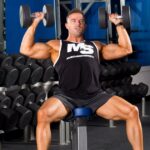Building muscle and strength is one of the most rewarding fitness goals. Whether you’re a beginner just starting your journey or an experienced lifter looking to break through plateaus, understanding the best workout routines is essential. The combination of proper training, nutrition, and recovery will help you sculpt your body, enhance endurance, and boost overall health.
Why Building Muscle and Strength Matters

Developing muscle and strength goes beyond aesthetics. Strong muscles improve posture, bone density, and metabolism. They also reduce the risk of injury and enhance athletic performance. The key to achieving muscle growth lies in progressive overload — gradually increasing the resistance your muscles face during workouts.
When you commit to a structured workout plan, you not only gain physical benefits but also experience mental clarity and improved confidence. Exercise releases endorphins, which enhance mood and reduce stress, making fitness a powerful tool for overall well-being.
Best Workout Routines for Muscle and Strength
Choosing the right workout routine depends on your goals, fitness level, and available time. Below is a guide featuring some of the most effective routines for gaining muscle and building strength.
| Fitness Goal | Exercise Type | Description | Diet Plan Recommendation |
| Muscle Building (Hypertrophy) | Weight Training | Focus on 8–12 reps per set with moderate weight. Include compound lifts like bench press and squats. | High-protein diet (chicken, fish, eggs, whey protein) |
| Strength Training | Powerlifting | Perform low-rep, high-weight lifts: squats, deadlifts, and bench press. Focus on form and rest. | Balanced macronutrients with complex carbs and lean proteins |
| Fat Loss and Toning | HIIT (High-Intensity Interval Training) | Alternate short bursts of intense activity with rest or low-intensity movement. | Calorie deficit diet, high in fiber and lean proteins |
| Full-Body Fitness | CrossFit | Mixes strength, endurance, and cardio in a timed circuit format. | Balanced diet with focus on recovery meals |
| Endurance and Core Strength | Bodyweight Exercises | Includes planks, push-ups, pull-ups, lunges, and burpees. | Moderate carb intake and plenty of hydration |
Understanding the Science Behind Muscle Growth
Muscle growth, or hypertrophy, occurs when muscle fibers are broken down during resistance training and rebuilt stronger through proper nutrition and rest. This process requires progressive overload, meaning you should gradually increase the intensity of your workout over time.
There are two types of muscle hypertrophy:
- Myofibrillar Hypertrophy – Increases muscle density and strength through heavy lifting with low reps.
- Sarcoplasmic Hypertrophy – Increases muscle size by enhancing glycogen storage through moderate weight and higher reps.
For optimal results, a combination of both types is recommended.
Top Workout Splits for Building Muscle
To effectively train all muscle groups, it’s important to follow a structured workout split. Here are some of the best options:
1. Push/Pull/Legs Split
- Day 1: Push (chest, shoulders, triceps)
- Day 2: Pull (back, biceps)
- Day 3: Legs (quads, hamstrings, calves)
- Day 4: Rest or repeat cycle
2. Upper/Lower Split
- Day 1: Upper body (bench press, rows, overhead press)
- Day 2: Lower body (squats, deadlifts, lunges)
- Day 3: Rest
- Day 4: Repeat
3. Full-Body Routine
Perfect for beginners or those with limited time. Perform compound exercises that target multiple muscle groups, such as squats, deadlifts, and pull-ups, three times a week.
Essential Exercises for Muscle and Strength
To get the most out of your workout, focus on compound movements. These exercises recruit multiple muscle groups and stimulate greater muscle growth.
Compound Exercises
- Squat: Builds legs and core stability
- Deadlift: Strengthens the back, glutes, and hamstrings
- Bench Press: Develops chest, shoulders, and triceps
- Pull-Up: Enhances upper back and biceps
- Overhead Press: Improves shoulder size and power
Isolation Exercises
These target specific muscles for balanced growth:
- Bicep curls
- Tricep extensions
- Lateral raises
- Leg curls
- Calf raises
Nutrition for Muscle and Strength
No workout routine is complete without proper nutrition. Muscles need fuel and nutrients to grow and recover effectively. Here’s how you can optimize your diet:
- Protein: Essential for muscle repair. Include lean meats, eggs, Greek yogurt, tofu, and whey protein.
- Carbohydrates: Provide energy for training. Choose complex carbs like oats, brown rice, and sweet potatoes.
- Fats: Support hormone production and recovery. Include sources like avocados, nuts, and olive oil.
- Hydration: Water aids digestion and muscle function. Drink plenty throughout the day.
- Supplements: Consider protein shakes, creatine, and BCAAs for performance and recovery support.
Recovery: The Hidden Key to Growth
Muscles don’t grow during your workout; they grow while you rest. Recovery is just as important as training itself. Lack of sleep or overtraining can lead to fatigue, injury, and stagnation.
Tips for Better Recovery
- Sleep: Aim for 7–9 hours per night
- Stretching: Reduces soreness and improves flexibility
- Active Rest Days: Engage in light activities like walking or yoga
- Massage or Foam Rolling: Helps relieve tight muscles
Beginner’s Guide to Starting a Workout Routine
If you’re new to fitness, start slow and focus on mastering proper form before adding heavy weights. Consistency is more important than intensity in the beginning. A simple beginner workout might look like this:
Day 1 (Full Body):
- Squats – 3 sets of 10
- Push-ups – 3 sets of 10
- Dumbbell Rows – 3 sets of 12
- Plank – 3 sets of 30 seconds
Day 2 (Rest or Light Cardio)
Day 3 (Full Body):
- Deadlifts – 3 sets of 8
- Bench Press – 3 sets of 10
- Pull-Ups or Lat Pulldowns – 3 sets of 8
- Lunges – 3 sets of 12 per leg
Gradually increase the weight or intensity each week to continue making progress.
Conclusion: Achieving Muscle and Strength for Life
Building muscle and strength is a long-term journey that requires discipline, patience, and the right workout plan. By combining resistance training, balanced nutrition, and adequate recovery, you can transform your body and improve your overall health. Remember, consistency is key—stick to your plan, stay motivated, and track your progress











